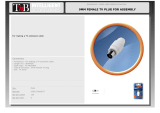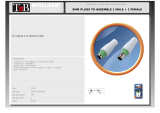Page is loading ...

System Q SIDE A - 24/01/05 Doc XCCT455
CCT455/7/9 Varifocal CCTV Dome Camera INSTRUCTIONS
System Q E-mail support@systemq.com or fax support 01246 222 888
Varifocal Auto Iris CCD Dome Camera
Introduction
Each of the Varifocal dome has been engineered from a solid piece of
aluminium to produce a truly exceptional product.
With the domes stunning looks and great functionality you shouldn’t loose
many jobs
The beauty of this product is not just on the outside, the dome comes equipped
with a Varifocal lens that allows you to get the picture that your customer was
expecting when you are installing. It also has an auto iris lens, so when looking
at a doorway the camera will compensate for any bright sunlight.
The domes’ stunning looks means that they look the part in any environment.
Installed in a shop, office, bank, school or an industrial unit the domes look and
perform great.
The Varifocal lens means that the cameras can be adjusted for a wide angle of
view or a narrow angle distance shot so they can capture the exact scene your
customer wants without you having to worry about what lens to order.
As the lens is auto-iris it can accommodate a wide range of lighting conditions improving the cameras performance in
low light whilst also coping with bright sunlight or shop lights effortlessly.
The cameras electronics have been designed around the latest semiconductor technology and circuit design to ensure
that all three variants of the camera produce an excellent picture quality to match the cameras stunning looks.
Models Covered in these instructions
CCT455 Hi-Res B&W Dome with Vari-focal Lens
CCT457 Med-Res Colour Dome with Vari-focal Lens
CCT459 Hi-Res Colour Dome with Vari-focal Lens
Camera Specifications
Camera Spec Hi-Res B&W Med-Res Colour Hi-Res Colour
Image Sensor 1/3” B&W 1/3” Col. Sharp 1/3” Col. SONY Ex View
Image Output
1V
pk-pk
75Ω 1V
pk-pk
75Ω 1V
pk-pk
75Ω
Resolution 600TVL min 380TVL min 480TVL min
Min Illumination 0.03 Lux 0.5 Lux 0.25 Lux
Input Voltage Range 12V DC / 24V AC 12V DC / 24V AC 12V DC / 24V AC
Power Consumption 200/100 mA 200/100 mA 200/100 mA
Lens 4-9mm Vari-focal 4-9mm Vari-focal 4-9mm Vari-focal
AGC Automatic Automatic Automatic
Iris Control Auto Iris Auto Iris Auto Iris
Size, Dia x H 110mm dia x 80mm H 110mm dia x 80mm H 110mm dia x 80mm H
Mounting the Camera
The dome cameras are supplied with a fixing plate and drilling template that allow to fix your dome
camera (using the screws supplied) to wood or brick with wall plugs (not supplied) or to
plasterboard / suspended ceilings with bolts and fixing plate (supplied).
Powering the Camera
The dome cameras are dual voltage i.e. you can use them on a 12V DC system or a 24V AC system. The camera has
built in power supply control circuit for ease of connection; this means that you can connect to any 12VDC or 24VAC
system without worrying about polarity or voltage regulation.
The camera is provided with a screw terminal on a fly lead that allows you to connect the power supply to it.

System Q SIDE B - 24/01/05 Doc XCCT455
CCT455/7/9 Varifocal CCTV Dome Camera INSTRUCTIONS
System Q E-mail support@systemq.com or fax support 01246 222 888
When powering the camera with a 12V DC power supply, ensure that the supply is regulated and has a continuous
rating of 100mA or higher per camera. It is recommended to use a power supply that is rated higher than the current
consumption of the camera i.e. POW100 would be adequate for powering a single camera but when powering two or
more you should look at the bigger power supplies that are available from System Q; this prevents the PSU from
running at its maximum rating for long periods of time.
If you are using the System Q Easy Connection Kit (CCT806/7) to power and connect your camera (12V models only)
please proceed as per the instructions supplied with The Easy Connection Kit. You will need to cut off the DC Plug
ONLY and use the bare wires to connect to the terminal strip. The 12V positive is the RED wire the 0V is the BLACK
wire.
Using 24V AC power
Using a suitable cable between the 24V AC power supply (POW600) and the camera you can connect the
power to the cameras terminal strip either way around. As the power is 24V AC, (alternating current), the
polarity is not important. You must use a separate cable for power and video. It is recommended you use a
2/4-core cable to carry the AC power to the camera and use an RG59 or twisted pair cable to bring the video
signal back from the camera to the monitor / control equipment.
Connecting the camera to control equipment.
The dome camera comes with a fly lead for power and video out. To reduce installation time the video out lead is
terminated into a male BNC connector. This allows the installer to effortlessly connect the camera to control
equipment via a female BNC-BNC lead.
Remember that the Video out from the camera is like any other electrical circuit and requires two wires to complete
the circuit. When using a co-ax type cable such as RG59 or similar, the outer braid of the co-ax provides the “0V
GROUND” connection and the inner core provides the “Video” connection.
It is recommended that when you are first setting up the cameras that you use a short BNC-BNC cable to link the
camera directly to the monitor and to set it up at the same time. This allows you to both understand the camera and get
the very best out of this great product as you will be able to adjust the camera whilst looking at the monitor screen.
Obviously whilst you are setting up the camera, it does need to be powered!
Dipswitches
The CCT455 has a bank of four dipswitches.
The CCT457 (Mid Res Colour) has three dipswitches:
Switch 1 Electronic Iris
Switch 2 Auto Iris
Switch 3 Back Light Compensation

System Q SIDE C - 24/01/05 Doc XCCT455
CCT455/7/9 Varifocal CCTV Dome Camera INSTRUCTIONS
System Q E-mail support@systemq.com or fax support 01246 222 888
The CCT459 (High Res Colour) has four dipswitches.
Switch 1 Iris Control (Auto Iris=ON, ESC=OFF)
Switch 2 Back Light Compensation (ON=BLC ON)
Switch 3 Automatic Gain Control (ON = ALC ON)
Switch 4 FL/Flicker less (ON = FL on)
1. Automatic Level Control / Electronic Shutter Control (ALC / ESC)
This must be set to ALC when using these cameras with the standard Auto Iris Lens. If switched to
ESC, the camera will still function but the picture quality will be erratic being too bright or too dark with
poor colour reproduction as both the camera and the lens would be fighting to compensate for varying
light levels.
(The Electronic shutter control is driven from the electronics on the pcb, the ALC relies on the
functioning of the Auto Iris in the lens.)
2. Back Light Compensation (BLC).
BLC helps the camera when it is looking at a bright object such as an external window. The BLC tries to
compensate for the bright part of the image so that some of the surrounding area is not too dark.
It is recommended always to be set to on.
3. Automatic Gain Control (AGC)
When the light falling on to an imaging device reduces to a certain level, there may be insufficient to
create a full level video signal. The AGC acts to increase the amount of amplification in these
conditions to bring the signal up to the required level. As well as amplifying the video signal, additional
noise can be introduced, and the signal to noise ratio reduced. The result can lead to a very much-
degraded signal and poor picture on the monitor.
4. Flicker - less Function (FL)
Set the dipswitch 4 FL to ON to enable the flicker - less function, when in this mode, the AES/OFF
switch is automatically disabled.
Sometimes the picture can be seen to ‘Flicker’ or ‘Pulse’, setting this switch to ON will prevent this
problem.
Lens Adjustment
When setting the lens to suit your particular application, remove the cover and inner lens surround, loosen
off the locking screws and alter the focal / Tele/wide adjustments. When the desired picture is achieved
tighten the locking screws and replace the covers.
There are two sections to the lens that can be modified, the focal adjustment that allows you to alter the
position of the focal lens in order to focus the lens. The Tele/wide adjustment allows you to achieve the
required angle. The Tele/wide adjustment will ‘zoom’ into or away from the object in the picture, depending
on how much of the area is required to be in view.
TIP: When you are setting up the cameras on site it pays to have a test monitor with you so that
whilst you are up ladders to can position the lens without having to go up and down to the monitor
to check on the camera setting. CCT020 4” LCD Test Monitor or the CCT021 6.8” LCD Test Monitor

System Q SIDE D - 24/01/05 Doc XCCT455
CCT455/7/9 Varifocal CCTV Dome Camera INSTRUCTIONS
System Q E-mail support@systemq.com or fax support 01246 222 888
Trouble-shooting Tips
Picture too bright or dark:
• The ALC control is set incorrectly
• The BLC switch needs setting
• The camera is set for Electronic Iris and not Auto Iris
No Picture.
• Check the supply voltage to the camera. This can be anywhere between 12-24volts ac/dc
• Check the BNC video lead connection. Remember that like any other electrical system the video
signal requires a 2-wire connection. The centre core carries the video signal and the outer core or
screen is the ‘video signal return’
Poor Night Time Pictures:
• Check the dipswitch configuration, the camera is supplied with an auto iris lens as standard and they
should be set for Auto Iris and not Electronic Iris.
• Check the set-up of the camera in its brightest operating conditions and adjust the ALC control as
described in the instructions.
• Check there is sufficient lighting available for the area under observation, if it is not possible to see
anything in the dark yourself it is unlikely that the camera will see anything either. TIP: Take a lead
lamp to the site and try recording the picture with the light in different places; this will help
solve or highlight any lighting issues.
Poor Focus:
• Check the lens adjustments for focus and set for best possible picture as required.
• Check the ALC control. This controls the iris aperture and if it is too open then the picture will not be
sharp. This is best set-up in the brightest operating conditions. See the ALC section.
• Check that the dome cover is clean.
• Check that there is or has been no moisture ingress through a poor seal or cable entry. This usually
leaves tell tale smears on the inside of the dome cover.
/



